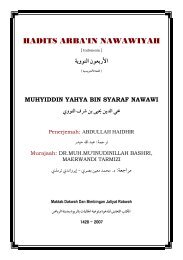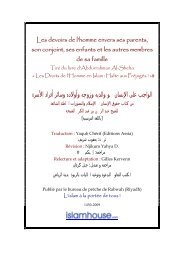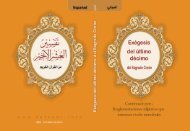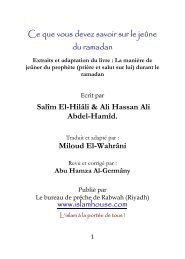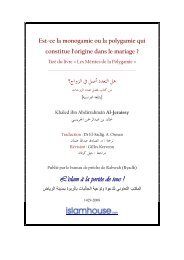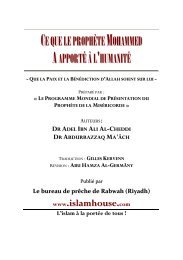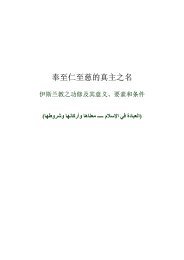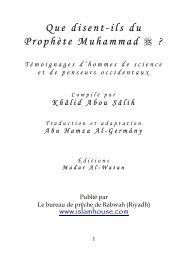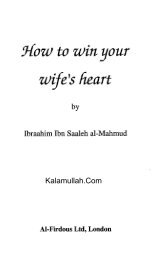is allah (sw) one or three? - Islam Center
is allah (sw) one or three? - Islam Center
is allah (sw) one or three? - Islam Center
Create successful ePaper yourself
Turn your PDF publications into a flip-book with our unique Google optimized e-Paper software.
(٥٠)IS ALLAH (S.W) ONE OR THREE?of course - it does not include “Allah (S.W)-fearing”, because it <strong>is</strong> H<strong>is</strong>character<strong>is</strong>tic. 1B.The Beginning of the Gospel Acc<strong>or</strong>ding to JohnTaking the beginning of the Gospel acc<strong>or</strong>ding to John as evidencef<strong>or</strong> Jesus’ (PBUH) divinity, “In the beginning was the W<strong>or</strong>d,and the W<strong>or</strong>d was with God, and the W<strong>or</strong>d was God. Hewas in the beginning with God. All things were madethrough him, and without him was not any thing made thatwas made.”(John 1/1-3), made scholars point out many imp<strong>or</strong>tantpoints:- Scholars brought to our attention, that the writer of th<strong>is</strong> Gospel hadplagiarized th<strong>is</strong> passage from Philo Alexandrian (40 C.E.). Phel<strong>is</strong>ianShali says, “The idea of the W<strong>or</strong>d (logos) comes from the Stoicalphilosophers and from the Jew<strong>is</strong>h philosopher (Philo), and b<strong>or</strong>rowedfrom these creeds and the<strong>or</strong>ies by Saint Justin, and, by the writer ofthe first lines of the Gospel, which <strong>is</strong> attributed to Saint John. 2Scholars believe that the term (w<strong>or</strong>d) with its philosophical structure<strong>is</strong> different from Jesus’ (PBUH) culture, the simplicity of h<strong>is</strong> w<strong>or</strong>ds,and the language of h<strong>is</strong> d<strong>is</strong>ciples, especially John whom the Book ofActs describes as illiterate and slang-spoken. It says, “Now whenthey saw the boldness of Peter and John, and perceived thatthey were uneducated, common men, they wereaston<strong>is</strong>hed.” (Acts 4/13)- Deedat menti<strong>one</strong>d that there <strong>is</strong> a fabrication in the Engl<strong>is</strong>htranslation, which <strong>is</strong> the <strong>or</strong>igin of all other translations of the HolyBible.1 -The reader may become confused with the description of the w<strong>is</strong>dom in Proverb: “thenI was beside him, like a master w<strong>or</strong>kman, and I was daily h<strong>is</strong> delight, rejoicingbef<strong>or</strong>e him always, rejoicing in h<strong>is</strong> inhabited w<strong>or</strong>ld and delighting in the children ofman.” (8:30-31) which indicates that the w<strong>is</strong>dom <strong>is</strong> a creat<strong>or</strong>. In fact, it <strong>is</strong> an intendedfabrication. The same verse in the Monastic Jesuit Edition, <strong>is</strong> as follows, “then I was byhim h<strong>is</strong> nursling, and I was daily h<strong>is</strong> delight, rejoicing always bef<strong>or</strong>e him, rejoicingin h<strong>is</strong> inhabited w<strong>or</strong>ld”, it does not talk about the w<strong>is</strong>dom that creates, but about thechild’s w<strong>is</strong>dom, which begins in childhood and grows as the person grows.2 - Summary of the H<strong>is</strong>t<strong>or</strong>y of Religions, Phelsian Challi, pp 247, The Holy Bible’sDictionary, pp 903.




